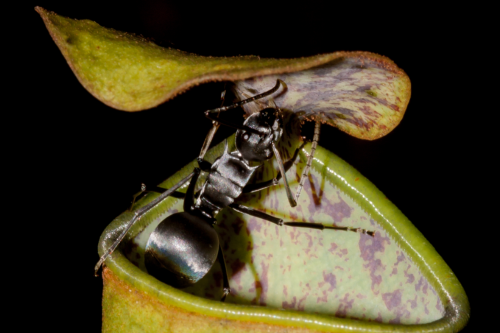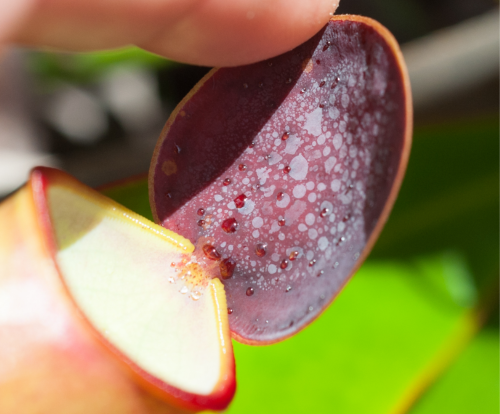
A large Polyrhachis pruinosa ant feeds on sweet nectar secretions on the underside of an N. gracilis pitcher lid. Ulrike Bauer

The wax crystals on the underside of the N. pervillei pitcher lid are visible to the naked eye as a glaucous sheen. Ulrike Bauer
A scientific study of pitcher plants species that use the same complex 'springboard' mechanism for insect capture has revealed an explanation for how complex traits requiring multiple components may evolve.
An international team of researchers led by Dr Ulrike Bauer from the University of Bristol investigated two tropical pitcher plant species growing separated by 4000km of open ocean: the Slender Pitcher Plant (Nepenthes gracilis) found in Borneo, and Nepenthes pervillei from the Seychelles islands off the East coast of Africa.
Dr Bauer and her team found that both plants had independently evolved the same unusual 'springboard' mechanism to capture insects. When falling raindrops hit the roof-like trap lid of the pitcher plant, insects standing on the underside of the trap lid are catapulted into the trap below.
This springboard trapping mechanism only works if three independent traits come together. First, the lid needs to be horizontal so that the catapulted prey land inside the trap. Second, the lid needs to act as a spring so that the impact energy of the raindrop is transferred to the insect. Finally, the underside of the lid is covered with a layer of fine wax crystals that give it just the right level of slipperiness – grippy enough for insects to walk upside down under the still lid, but slippery enough for them to lose grip when a drop hits. All three components are necessary for the trap to work. Springboard trapping is what Dr Bauer calls a 'composite trait'.
Evolutionary biologists struggle to explain the emergence of such composite traits. "We learn in school that evolution works by natural selection acting on naturally variable traits," Dr Bauer explains. Individuals with advantageous traits have more offspring, and thus over time, the frequency of genes underlying the advantageous traits increases in the population."
"This simple concept explains how giraffe necks got longer and cheetahs got faster over time, but it struggles to explain the emergence of entirely novel traits, especially where these originate from a combination of multiple, previously unrelated components, such as the pitcher plant's springboard mechanism."
Dr Bauer and her team developed an alternative hypothesis for composite trait evolution: spontaneous coincidence, or in other words, a chance encounter of a new beneficial combination.
"Our research showed that in the majority of Nepenthes pitcher plant species, the three component traits of the springboard trapping mechanism are unusually variable," Dr Bauer said.
"This increased the pool of possible trait combinations, and therefore the likelihood of a beneficial new combination. In this case it is actually the absence of strong selection that facilitates evolution, as it allows the traits to be more variable, in turn increasing the number of 'tickets' in the evolutionary lottery."
PAPER
'Convergence in carnivorous pitcher plants reveals a mechanism for composite trait evolution' by Chomicki, G., Bauer, U., Burin, G., Mortimer, B., Godzdik, J. and Jetter, R., in Science, January 2024






